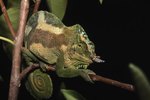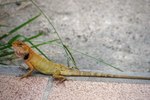Flying geckos (Ptychozoon sp.) have been known to Western science since at least 1809, but many aspects of their natural history remain a mystery. Scientists don't even agree on how many species of flying gecko exist; between five and nine species are recognized by various authorities. At least this much is known: Flying geckos are small, tropical lizards with extraordinary adaptations to suit their arboreal lifestyle.
Description
Flying geckos reach about 6 to 8 inches from tongue to tail tip. They feature prominent skin flaps along their sides, tail and feet. Though the color and pattern vary greatly from lizard to lizard, most are incredibly well camouflaged and blend in superbly with their habitat; a quality that helps them to avoid predators. Though the skin flaps likely help the lizard's camouflage, a 1976 study by Dale L. Marcellini and Thomas E. Keefer, published in "Herpetologica," found that camouflage was not the primary purpose of the flap -- rather, the flaps evolved to enable gliding behavior.
Gliding Behavior
Flying geckos are not capable of true powered flight. Rather, they will extend their legs and tails, maximizing their surface area, and passively glide from tree to tree. Though flying geckos don’t have control over their "wings" like flying dragons (Draco sp.) do, they have similar surface area and flight capabilities, as was shown in a 2001 study by Anthony P. Russel et al. and published in the "Journal of Morphology."
Natural History
Flying geckos are found in tropical forests throughout Southeast Asia. After spending their days clinging to tree trunks and sleeping, these nocturnal lizards emerge at nightfall to hunt insects, spiders and small vertebrates. Snakes, monitor lizards and predatory birds are important predators of the geckos, who will try to defend themselves by running or gliding away from predators.
Reproduction
Flying geckos will breed and produce eggs every three or four weeks, when the climactic conditions are favorable. Like most other geckos, flying geckos deposit their eggs in pairs. Wild lizards deposit their eggs in concealed locations on trees, while captive lizards may attach them to the cage glass. The young hatch in about three weeks, looking like smaller versions of the adults.
Captive Care
In captivity, flying geckos thrive in a tropical terrarium of sufficient size. A 10-gallon aquarium will serve a pair of geckos, though bigger is preferred. The habitat needs a thermal gradient, typically created by placing a heat lamp or heating pad at one end of the enclosure. The warm side of the habitat should reach the middle 80 degree range Fahrenheit during the day and drop into the middle 70s at night. Feed the geckos crickets or roaches five or six times per week, and mist them daily to maintain the humidity and supply drinking water. Live or artificial plants and numerous hiding spots should be provided so the geckos will feel secure. Wild-caught animals will require veterinary care to address possibly present parasites.
References
- Journal of Morphology: Structural Characteristics of the Patagium of Ptychozoon kuhli (Reptiles: Gekkonidae) in Relation to Parachuting Locomotion
- Herpetologica: Background Color Selection and Antipredator Behavior of the Flying Gecko (Ptychozoon kuhli)
- The Reptile Database: Ptychozoon kuhli
- Zootaxa: A New Species of Parachute Gecko (Squamata: Gekkonidae: Genus Ptychozoon) from Kaeng Krachan National Park, Western Thailand
- Herpetologica: Analysis of the Gliding Behavior of Ptychozoon lionatum (Reptilia: Gekkonidae)
- Gekkota.com: Flying Geckos (Ptychozoon sp.)
- The DNA of Singapore: Ptychozoon kuhli





